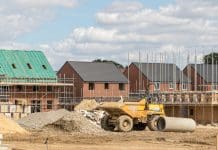The committee held an inquiry into the policy and have found that it has “been rushed and not properly thought through”
The committee has today sent a letter to the deputy prime minister, Angela Rayner, stating that the grey belt policy is not likely to make a difference to how many new homes can be built.
The grey belt policy was intended to expand settlement areas
The policy had the potential to unlock sites on the boundaries of existing communities, such as out-of-use carparks or abandoned industrial areas.
The House of Lords Built Environment Committee found that the policy should have what is defined as grey belt land make a limited contribution to green belt principles in order to mitigate local opposition.
Last month, the final updated National Planning Policy Framework (NPPF) was published which included the requirement for local authorities to review their green belt boundaries, and then propose alterations if they can’t satisfy their need for homes or other developments.
The committee finds that these changes to the NPPF will likely make the grey belt concept redundant, especially with its lack of a clear definition, in hitting housing targets. The gap for how many potential homes can be built on grey belt land is anywhere from 50,000 to 4m.
The government has also not stated a clear plan to track the progress of the policy, nor assess its effectiveness. Furthermore, the committee found that the Government does not have a clear understanding of the implications of introducing multiple planning policies at once, and this hurts the ability to deliver policies in a coherent way.
“Effective policy must be evidence based”
The committee also found that, even if homes are built on grey belt land, their sustainability is not guaranteed as this will largely depend on public transport infrastructure, social infrastructure, and environmental considerations.
Other concerns that the committee inquiry had into the grey belt policy include their potential to support SME housebuilders, as some grey belt sites are too small to be of interest for large businesses. However, there will still be a large skew towards large businesses due to the affordable housing requirement.
There are concerns raised that local authority planning departments will not have the required resources to deliver the change required of them, even with the government’s funding to recruit an additional 300 planners per authority.
The committee also write about undesirable effects of encouraging speculative applications for green belt developments, contradicting the government’s plan to release green belt land in a controlled manner.
Lord Moylan, chair of the Built Environment Committee, said: “Last autumn our committee launched this inquiry into ‘grey belt land’ because the committee believed that this new category could make a positive contribution to meeting housing targets.
“The Government’s policy been implemented in a somewhat rushed and incoherent manner. The committee does not believe that it is likely to have any significant or lasting impact on planning decision-making or helping the Government achieve its target of building 1.5 million new homes by the end of this Parliament.
“In December the Government published the final NPPF and the revisions it has made to the framework have now made the concept of grey belt land largely redundant as land will now be more likely to be released from the Green Belt through existing channels instead.
“The Government also does not seem to have any plan to measure progress or determine the success of this policy. Effective policy must be evidence based and be able to demonstrate its efficacy. Sadly, this is not the case here.”














